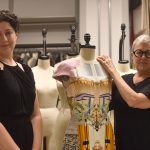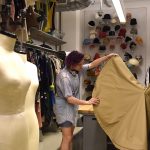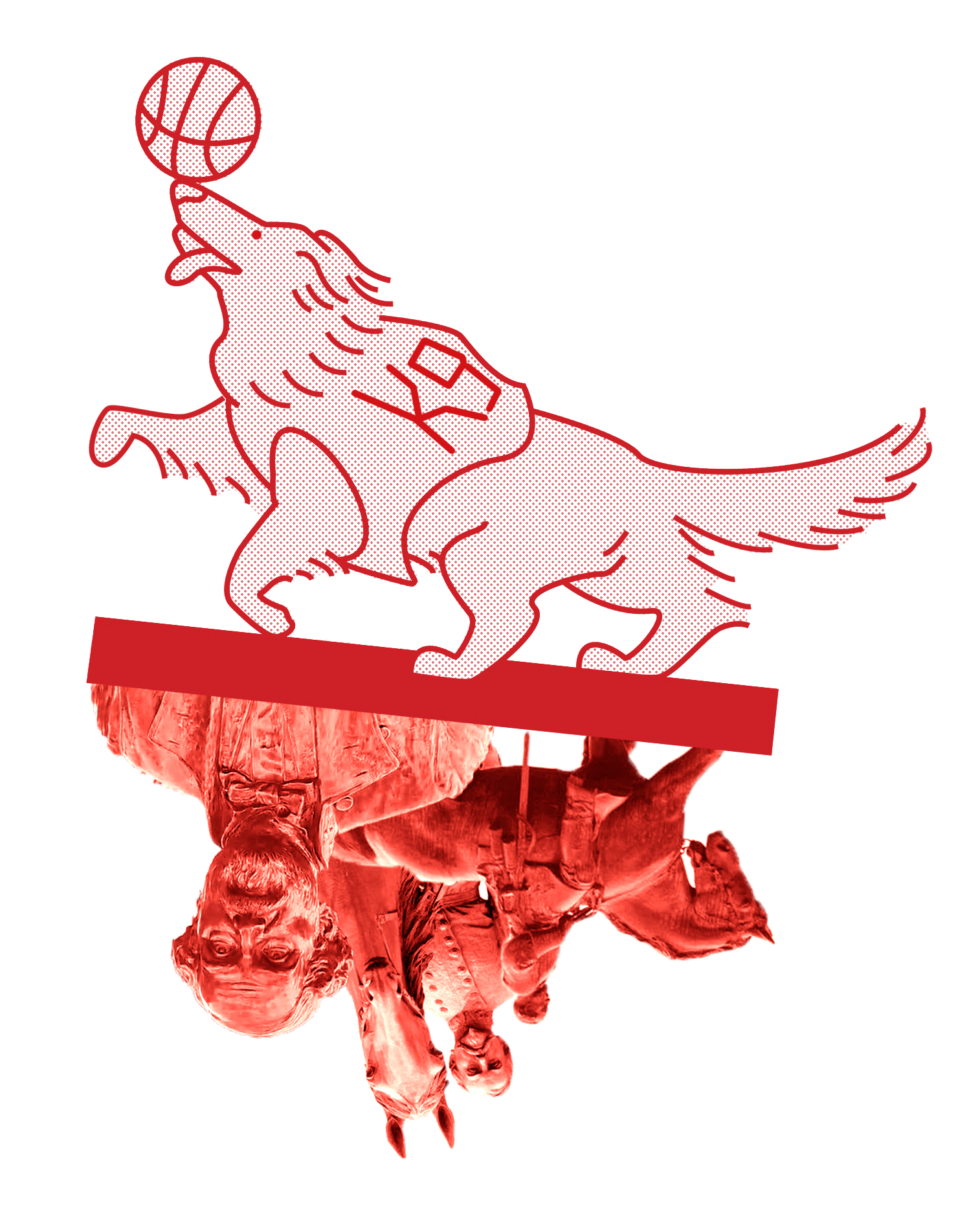Adjunct Professor of Art History, Gillion Carrara, founded the School of the Art Institute of Chicago’s (SAIC) Fashion Resource Center (FRC) in 1987. 30 years later, the FRC is one of seven Special Collections shared by SAIC and the Art Institute of Chicago. The collection includes over 3,000 published texts, 800 garments, and 800 videos of Ready-to-wear and Couture runway shows. As one of the only hands-on fashion archives in the world, the FRC provides SAIC students with a one-of-a-kind research experience. F News sat down with founder Gillion Carrara and co-director Caroline Bellios to discuss the FRC’s history and impact.
F News: What was involved in starting the FRC?
Gillion Carrara: Probably more than 30 years ago, I attended meetings of the Costume Society of America. By traveling to those different cities for the national and local meetings, I was getting to know and admire a lot of curators. I went to various museums, not school collections because there weren’t any. I was trying to figure out what we needed for the school community.
I went to LA, I went to the Fashion Institute of Technology (FIT), I went to Minneapolis, and I asked how they dealt with guests. But it was FIT where I really learned the most. I was taught what to do and what not to do. Don Petrillo taught me how to handle guests: “You’re not a museum, you’re a resource center within a school.”
So, I listened to everyone and I took notes. I talked to the Chair of the Fashion Department at SAIC, who took me to the President and the textile collection at the museum. We established that we would eventually be a hands-on study collection of garments that would be donated.
We started in a closet in the Columbus drive building when the Fashion Department was just one room. I thought, how was I going to document them? I took notes; I put little notes on each hanger; it became quite popular. So, instead of waiting on faculty to donate garments for students, I began asking friends for donations. I was talking to wealthier friends and art collectors who were fashionable. I was listening to the directors of other collections as to how to build a collection.
We moved to what is now the Fibers Department resource center. We were there for a number of years. I had a room down the hall that served as my office, but I’d have to constantly go back and forth. Once in a while I’d have a student assistant, but it didn’t work out. Pretty quickly, a friend over at the museum in the AIC volunteer services department said, “You know, we have people who want to volunteer but we don’t have a fashion department.” So, she taught me how to interview and attract volunteers. That’s how it all started.
Caroline Bellios: I’d always heard that Leah Bowman really did say, “We need to start a collection” and asked Gillion to take it on. Leah was the chair of the department and she hand picked Gillion out of everybody in the department, thinking that her skill set would be the best for developing and protecting this kind of collection.
F: Caroline, how did your involvement with the FRC begin?
CB: So, I’ve been here for ten years. As Gillion said, she worked with various student assistants over the years and it’s difficult to create a consistent relationship because the students are always moving on. Finally, she was given leave by the administration to hire a second person to work in the FRC. It was a good fit for me because I had done an undergraduate degree at the University of Chicago that focused on research and reading. I had also done a fashion degree at SAIC. A space that involves both fashion and research was an ideal place for me to work. Gillion hired me, and I’ve been working at the collection ever since.
F: How do you go about collecting materials?
GC: We keep very little. When I go to events all over the city, people know me. I approach them and say, “Oh that’s a great dress. Would you ever consider donating it?” That’s happened quite a few times. We collect from individuals who have worn the garments. So, sometimes I call them and I go out and remind them that we had conversed.
We go to stores on sale, here in Chicago and in New York. We also are quite friendly with some of the designers, and they donate garments, or retail stores donate garments.
So, It’s sort of expanded from just picking from individuals in their homes. I’m always very, very, careful that we’re not invited to clean out their closets, I’m not interested in that. We want are significant garments. It’s been a challenge. Very often, individuals keep them.
F: Do either of you have wish lists of garments that you’d like to have?
CB: We’ve found many of them, but we haven’t found them within our budget. In addition to approaching individuals, and looking at stores in Chicago and elsewhere, we also are looking at online auction sites. People are selling things on eBay as well. Some of our garments have come from there. We have a very small acquisitions budget, we also utilize additional funding like what we make from the annual FRC Sale.
F: How do you collect and archive books?
CB: We have subscriptions to a number of contemporary magazines. Some of the magazines, like Vogue and Harper’s Bazaar, don’t cover the subjects that our students are interested in. We have art and design magazines, we have smaller independent fashion magazines.We will look for things; we take recommendations from students and faculty. We keep what seems to be interesting, and what students and faculty react to positively. With books, I am constantly looking through publishers’ new publication lists.
F: As a researcher, are there particular books or magazines that you think are important for fashion students at SAIC to read?
GC: I like the idea of having the odd book that the Flaxman might not have, or the Ryerson might not have. I know that a student recommended a book on plane crashes that was really interesting because it could be a point of departure for a collection in a positive way.
CB: My favorite is “1,000 Degrees Celsius Deyrolle,” which is a photographic essay about a taxidermy shop in Paris that suffered a great fire. A photographer came and photographed things [after the] fire. Some things were partially destroyed, some things were completely destroyed. The idea of decay, which appeals to a lot of students today. It provides a lot of insight into making because you get to see the inside of animals that had been deteriorated.
GC: We have a lot of biographies on the designers that I found in secondhand shops. I like the older books like “Dior and I” or “Shocking” by Schiaparelli.
F: How does the FRC differentiate itself from the other collections on campus, like the Ryerson or the Flaxman libraries?
CB: We look for books and resources that we think specifically work for ideas of fashion, ideas of identity, ideas of body, and body coverings. We try to be very specific in acquiring materials that relate to that. We’re also trying to find materials that would support the classes that we have here, and find materials that support the individual interests of students that are here.
I do believe that no matter what discipline somebody is working in, we can find books and garments here that relate to concepts that they’re working in. So, this idea that identity is so important, and our identity is tied to whatever we put on every day. No matter what type of work somebody is doing, we have materials in here that relate to what they’re learning
GC: The FRC is for the entire community. There isn’t one garment, book, magazine, file, DVD, VHS, that doesn’t have to do with the various classes, and topics, of interest.
F: How does the FRC compare to libraries at other design schools?
CB: We are very unique, partially because of the materials we collect, but mostly because of the access that we offer. We are a hands on collection, which for a museum collection is not typical. We are not a museum but we are a study collection.
The other thing that makes us very different is that we’re browseable. Students don’t have to make an appointment to come in, they don’t have to request anything. You’re free to wander into the wardrobe, and you’re free to pick up any item or object that interests you. So, it really is student-driven. You’re the one who is directing your own investigation. We find that other collections are impressed with that.
There are no other collections, that I’m aware of, where you can go take a 19th-century corset out of a box and touch it on your own. What’s always been important to me about the resource center is the idea of touch. Being able to touch the fabrics and the materials is so important to understand how they work with the body.
F: Are there any specific designers that you’re looking for?
GC: We’re always looking online for the young designers. We’re always aware, or we try to be aware, of what’s new, and we watch their progression. I think Caroline and I agree that it’s really important to get original Margiela, original Galliano, and original McQueen.
CB: One of the challenges that we have as a collection is that we are a high fashion collection. [High fashion] skews very white, and male. So, I don’t want to name specific designers right now that I’m looking for but I am trying to track some younger designers who represent a more diverse group of interests. We really value student input; oftentimes, students put someone on my radar.
F: In terms of diversity, what are some items and texts in the collection that would be useful to somebody who is interested in exploring non-male, non-white designers?
CB: The magazines that we bring in, because they are current, and because we are looking at magazines that explore more than just the mainstream, are a great place to start to see who is expanding the conversation of fashion, identity, and gender — and how gender plays a role in fashion.
One of my favorite things that we’ve gotten in the past few years is a pair of boots that are Commes des Garcons. They have these extremely long toes to them. They are based on a form of Mexican dancing boot from a very specific region of Mexico and a very specific time period. Men would wear these boots and dance in them. I really like those as an object in the collection because we have a Japanese designer who is borrowing from a Mexican community to create something that is then put on the runway in Paris. It’s an object that can spark a conversation about cultural diversity, cultural appropriation, and cultural appreciation.
GC: In the ‘60s, in New York and in Chicago, there were several prominent African American designers. We have a Scott Barry that came from a collector. We have Zulubet. To me, he was really avant garde.
F: Has the current political climate altered the way the FRC operates?
CB: I can’t think of ways it affects our collecting, but it does affect the way I talk about the collection to people who come in. I find myself emphasizing the importance of fashion in identity.
The Fashion Resource Center is located on the 7th floor – room 735 – of the Sullivan Building, and is open from 9:00 am to 4:00 pm Monday through Saturday, and 9:00 am to 6:00 pm on Thursdays.











